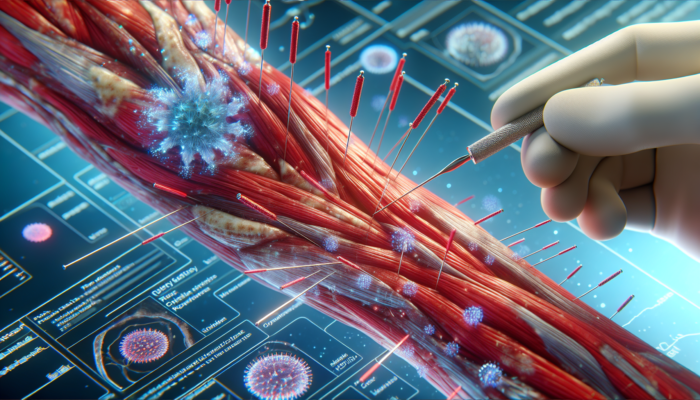Unlocking the Power of Acupuncture Techniques for Effective Tendonitis Pain Relief
Understanding Tendonitis: Key Causes and Symptoms You Need to Recognize

Acupuncture for tendonitis relief is a highly effective therapeutic approach that addresses the challenges of this painful inflammatory condition affecting the tendons—strong, fibrous tissues that connect muscles to bones. Tendonitis can develop due to a variety of factors, including repetitive motion, overuse injuries, or acute trauma, rendering individuals from different professions susceptible. Athletes, manual laborers, and even those who work at desks are at an increased risk of developing tendonitis owing to the physical demands of their jobs. Common types of tendonitis include tennis elbow, Achilles tendonitis, and rotator cuff tendonitis, each presenting specific challenges that necessitate customized treatment plans.
The symptoms of tendonitis often present as localized pain, tenderness, noticeable swelling around the affected joint, and stiffness that becomes increasingly pronounced during movement. These symptoms can severely impede daily activities, diminishing overall quality of life. Recognizing these symptoms early is crucial for prompt intervention and effective healing. If you find yourself experiencing these discomforts, seeking professional help through Acupuncture for tendonitis treatment could be a critical step toward alleviating your pain and restoring your normal functionality.
Diving Deep into the Science That Powers Acupuncture's Healing Effects
<a href="https://mcrtherapies.co.uk/acupuncture-for-skin-conditions-discover-transformative-relief/">Acupuncture</a> is an ancient healing art rooted in Traditional Chinese Medicine (TCM), characterized by the meticulous insertion of ultra-fine needles into designated points on the body. From a Western medicine perspective, this technique is understood to stimulate the nervous system, triggering the release of neurotransmitters and hormones essential for pain relief and inflammation reduction.
Regarding tendonitis, acupuncture offers compelling advantages. By balancing the body's energy, known as Qi, acupuncture not only alleviates pain but also helps restore optimal physiological functions. The strategic insertion of needles can activate the body's self-healing processes, enhancing blood flow to the affected areas, which is crucial for effective recovery. This integrative method—balancing energy while promoting healing—positions acupuncture as a potent treatment option for individuals dealing with tendonitis.
Examining Scientific Research That Validates Acupuncture's Effectiveness
A rich body of scientific research emphasizes the efficacy of Acupuncture for tendonitis treatment. For instance, a systematic review published in a respected medical journal demonstrated that patients undergoing acupuncture for various tendonitis-related ailments experienced significant pain relief compared to those who did not receive treatment. Additional clinical trials have confirmed acupuncture's ability to reduce inflammation and speed up healing times.
Researchers underscore acupuncture's effectiveness in enhancing localized blood circulation, a crucial element for tendon recovery. A comprehensive analysis of these studies indicates that acupuncture is not merely an alternative therapy; it is a scientifically accepted method for effectively managing tendonitis.
Harnessing Acupuncture for Comprehensive Relief from Tendonitis Pain

Pinpointing and Activating Key Trigger Points for Optimal Pain Relief
Acupuncturists are extensively trained to identify specific trigger points associated with tendonitis, where discomfort and tension frequently accumulate due to repetitive motions or undue strain. By inserting needles into these targeted areas, practitioners can effectively reduce inflammation and alleviate pain.
For example, in cases of tennis elbow, needles may be skillfully placed around the elbow joint and in the forearm to relieve tension and stimulate the healing process. This targeted technique not only addresses immediate symptoms but also rectifies underlying issues contributing to discomfort, such as muscle imbalances or poor posture.
This focused approach can lead to significant pain relief and restoration of function, empowering patients to resume their daily activities without the debilitating effects of tendonitis obstructing their progress.
Boosting Blood Circulation and Healing Processes Through Acupuncture
A significant benefit of acupuncture is its ability to enhance blood circulation throughout the body. Improved blood flow is essential for healing, as it delivers vital nutrients and oxygen to damaged tissues. When dealing with tendonitis, acupuncture can significantly enhance circulation to the affected tendons, thereby expediting the recovery process.
Research shows that improved circulation not only alleviates pain but also supports the body's intrinsic repair mechanisms. As tendons heal more efficiently, patients often report reduced stiffness and increased mobility, thus facilitating a more active lifestyle following treatment. This highlights the importance of integrating acupuncture for tendonitis treatment as a crucial aspect of a comprehensive recovery strategy.
Integrating Acupuncture with Complementary Therapeutic Approaches for Optimal Outcomes

Acupuncture can be seamlessly integrated with various therapeutic modalities, offering a holistic approach to managing tendonitis. For example, the pain-relieving effects of acupuncture can significantly enhance the efficacy of physical therapy, allowing patients to engage more actively in their rehabilitation exercises.
Moreover, combining acupuncture with medication can optimize pain management strategies. While medications may provide immediate relief, acupuncture addresses the root causes of discomfort, helping to prevent recurrences. This synergistic approach not only improves overall treatment outcomes but also empowers patients to take an active role in managing their tendon health.
Customized Acupuncture Techniques for Various Types of Tendonitis
Specialized Acupuncture Techniques for Tennis Elbow Relief
Tennis elbow, clinically termed lateral epicondylitis, is characterized by pain on the outer elbow caused by repetitive overuse. Acupuncture techniques specifically designed for treating this condition often involve placing needles along the forearm, elbow, and shoulder regions.
Research supports the effectiveness of specific acupuncture points, such as LI10 and LI11, in alleviating pain associated with tennis elbow. By stimulating these targeted points, acupuncturists can effectively reduce inflammation and foster healing in the affected tendons, delivering rapid relief and enhancing functional outcomes for patients.
Numerous patients have reported significant reductions in pain levels after just a few treatment sessions, making acupuncture a highly sought-after adjunctive option for individuals looking to enhance conventional therapeutic methods.
Applying Acupuncture for Effective Management of Achilles Tendonitis
Achilles tendonitis can be particularly painful and restricting for athletes. Acupuncture offers a unique and effective method for managing this type of tendonitis. By targeting specific acupuncture points around the ankle and calf muscles, acupuncturists can effectively reduce inflammation while boosting circulation to the affected region.
Common acupuncture points such as GB34 and BL57 are recognized as beneficial for alleviating symptoms associated with Achilles tendonitis. Clinical evidence supports acupuncture’s role in enhancing flexibility and reducing pain in the Achilles tendon, ultimately allowing individuals to return to their athletic activities more swiftly.
Additionally, acupuncture aids in minimizing the risk of recurrence by addressing potential biomechanical factors that may have contributed to the initial development of the tendonitis.
Alleviating Pain and Enhancing Mobility in Rotator Cuff Tendonitis Treatments
Rotator cuff tendonitis is a prevalent condition characterized by pain and limited mobility in the shoulder area. Acupuncture plays a crucial role in managing this ailment by targeting specific points around the shoulder and upper back to relieve tension and promote healing.
Key acupuncture points, such as SI9 and LI15, are frequently used to effectively alleviate shoulder pain. This targeted approach enhances the range of motion and mitigates stiffness, allowing patients to engage in daily activities without discomfort.
When incorporated into a comprehensive rehabilitation plan, acupuncture can significantly improve recovery outcomes, making it an invaluable resource for anyone suffering from rotator cuff tendonitis.
Your All-Inclusive Guide to an Acupuncture Session for Tendonitis Treatment
First Consultation: Comprehensive Health Assessment for Tailored Care
Your experience with acupuncture for tendonitis treatment begins with an initial consultation. During this critical visit, the acupuncturist will conduct a thorough health history assessment, discussing your symptoms, lifestyle, and any prior treatments you have undergone. This detailed evaluation is essential for determining the most effective treatment plan tailored to your unique needs.
Be prepared to provide information regarding your pain levels, the duration of your symptoms, and any factors that may exacerbate your condition. This comprehensive understanding is vital for developing a personalized treatment strategy that effectively addresses your situation and encourages optimal healing outcomes.
Detailed Overview of the Acupuncture Procedure: What to Expect
During an acupuncture session, you will lie down comfortably while the acupuncturist prepares to insert needles into designated points on your body. These needles are exceptionally thin, and most patients report minimal to no discomfort during the insertion process.
The acupuncturist may leave the needles in place for approximately 20 to 30 minutes. During this time, you might feel a sense of relaxation and warmth as your body responds to the treatment, facilitating healing and pain relief.
Some patients may feel slightly groggy after the session, while others may experience a burst of energy. It is essential to communicate any sensations you experience during the treatment to your acupuncturist, as this feedback can help tailor adjustments for future sessions.
Post-Treatment Care: The Value of Follow-Up Sessions for Optimal Healing
After an acupuncture session, mild soreness or tenderness in the treated areas is common. This sensation is typically slight and subsides quickly. Your acupuncturist may provide specific aftercare instructions, such as avoiding vigorous activities for a brief period or applying heat to the treated area to enhance relaxation.
Follow-up sessions are crucial for monitoring progress and adjusting the treatment plan as needed. Consistent treatments can yield cumulative benefits, significantly improving your tendonitis symptoms over time.
How to Locate the Best Acupuncturist for Effective Tendonitis Treatment
Key Qualifications and Certifications to Ensure Quality Care
When seeking an acupuncturist to address your tendonitis, assessing their qualifications and certifications is vital. Look for practitioners who have completed accredited acupuncture programs and hold the necessary licenses to practice in their respective regions.
In many jurisdictions, acupuncturists must pass rigorous examinations to practice. Additionally, verifying memberships in professional organizations, such as the National Certification Commission for Acupuncture and Oriental Medicine (NCCAOM), can provide further assurance of their expertise and dedication to high standards.
A well-qualified acupuncturist will possess a thorough understanding of anatomy and physiology, particularly concerning musculoskeletal conditions like tendonitis, ensuring that you receive the highest quality of care tailored to your needs.
Important Questions to Pose Before Beginning Acupuncture Treatment
Before starting your acupuncture journey, it’s wise to ask potential practitioners several essential questions. Inquire about their experience specifically treating tendonitis, as well as their overall treatment philosophy.
Ask about the typical number of sessions they recommend for your condition and how they gauge progress. Additionally, discussing any supplementary therapies they may suggest alongside acupuncture can provide valuable insights. Clarifying the treatment plan will help alleviate any concerns and establish realistic expectations for your healing journey.
The Importance of Patient Reviews and Testimonials in Your Decision-Making Process
Patient reviews and testimonials can deliver invaluable insights into an acupuncturist's effectiveness. Look for online reviews on platforms such as Google, Yelp, or specialized healthcare websites.
Positive feedback regarding pain relief and overall satisfaction can indicate a practitioner’s skill level and the quality of patient care they provide. If possible, reach out to former patients to gather firsthand accounts of their experiences, as this can significantly inform your decision-making process.
Maximizing the Benefits of Acupuncture with Lifestyle and Home Care Strategies
Targeted Exercises and Stretches to Alleviate Tendonitis Symptoms
Incorporating targeted exercises and stretches into your daily routine can significantly amplify the benefits of acupuncture for tendonitis treatment. Gentle stretches focusing on the affected area can help maintain flexibility, while strengthening exercises support the surrounding muscles and reduce strain on the tendons.
For instance, wrist flexor and extensor stretches are particularly effective for relieving tension in cases of tennis elbow. Similarly, for Achilles tendonitis, calf stretches and range-of-motion exercises can aid in maintaining flexibility and mitigating stiffness. Always consult with your acupuncturist or a qualified physical therapist to ensure the exercises are suitable for your specific condition.
Nutrition and Supplements: Supporting Tendon Health for Optimal Recovery
Maintaining a balanced diet rich in anti-inflammatory foods can significantly enhance tendon health and recovery. Incorporating omega-3 fatty acids found in fish and flaxseeds, along with antioxidants from various fruits and vegetables, can help combat inflammation effectively and support overall physical well-being.
Moreover, supplements such as collagen, glucosamine, and turmeric may prove beneficial in promoting tendon health and alleviating pain. Always discuss any dietary changes or supplements with your healthcare provider to ensure they align with your treatment plan and overall health.
Preventing Tendonitis Recurrence: Lifestyle Modifications for Long-Term Health
Implementing lifestyle modifications that promote tendon health is essential for preventing the recurrence of tendonitis post-acupuncture treatment. Employing proper warm-up and cool-down routines during physical activities can significantly lower the risk of strain and injury.
Additionally, focusing on ergonomic practices at work and during sports activities can relieve unnecessary pressure on your tendons. Regular engagement in strength training and flexibility exercises will fortify the muscles surrounding your tendons, enhancing their resilience against injuries.
Taking a proactive approach to maintaining your tendon health, in conjunction with acupuncture treatment, can empower you to lead an active and pain-free lifestyle, free from the limitations imposed by tendonitis.
Frequently Asked Questions About Acupuncture and Tendonitis Treatment
What does acupuncture for tendonitis treatment involve?
Acupuncture for tendonitis treatment involves the insertion of thin needles into specific points on the body to alleviate pain and promote healing in the impacted tendons.
How many acupuncture sessions are typically necessary for tendonitis?
The number of sessions required can vary from person to person, but many patients notice improvements after 3 to 6 sessions, depending on the severity of their condition.
Is the acupuncture process painful?
Most individuals report minimal discomfort during acupuncture, as the needles are extremely thin. Some may experience a slight tingling or warm sensation during the treatment.
Can acupuncture be effectively combined with other treatment modalities?
Yes, acupuncture can synergistically complement other treatments such as physical therapy, medication, or massage therapy for comprehensive management of tendonitis.
Are there any side effects associated with acupuncture?
While acupuncture is generally considered safe, some individuals may experience minor soreness or bruising at the needle sites. Serious side effects are rare when a qualified practitioner administers the treatment.
How does acupuncture aid in reducing inflammation?
Acupuncture helps reduce inflammation by enhancing blood circulation and stimulating the release of anti-inflammatory chemicals within the body.
Can I engage in exercises after an acupuncture session?
It’s best to follow your acupuncturist's recommendations. Light stretching is generally encouraged, while strenuous activities should be avoided immediately following treatment.
What is the typical duration of an acupuncture session?
An acupuncture session usually lasts between 30 to 60 minutes, depending on the treatment plan and individual patient needs.
What type of clothing should I wear to an acupuncture appointment?
Wear loose, comfortable clothing that allows easy access to the treatment areas. This facilitates the acupuncture process and ensures a more relaxed experience.
How can I find a qualified acupuncturist?
Look for licensed practitioners with experience specifically treating tendonitis. Consider checking reviews or asking for referrals to ensure you receive quality care.
Presented By: Tendonitis Relief
The Article: Acupuncture for Tendonitis: Discover Effective Relief appeared first on https://mcrtherapies.co.uk
The Article Acupuncture for Tendonitis: Uncover Effective Solutions appeared first on https://mcrtherapies.com
The Article Tendonitis Solutions: Discover the Benefits of Acupuncture Was Found On https://limitsofstrategy.com


This post really sheds light on an issue many of us overlook until we’re in pain. I can relate to the struggle of tendonitis—I had a bout of Achilles tendonitis last year, and it was such a frustrating experience. I never realized how much I took my mobility for granted until I couldn’t jog without wincing. It’s interesting how your discussions around repetitive motion and overuse injuries really resonate with so many aspects of modern life, especially for those of us glued to our desks or involved in sports.
I can totally relate to your experience with Achilles tendonitis. It really does put things into perspective when you realize how much we rely on our bodies for everyday activities. It’s like a wake-up call—suddenly you’re aware of every little movement and how frustrating it is when something you once took for granted becomes painful.
Experiencing Achilles tendonitis can be a real wake-up call, can’t it? It’s surprising how much we take our mobility for granted until it feels compromised. Jogging should bring joy, not wincing pain. It’s a reminder that our bodies are finely tuned machines, and repetitive motion, whether from sports or long hours at a desk, can lead to real issues if we aren’t careful.
I’m glad to hear you found the post relatable! If you’re interested, I recently came across some great resources that dive deeper into managing and preventing injuries like tendonitis. Check them out for helpful tips!
https://glucohealthcare.com/emailoctopus